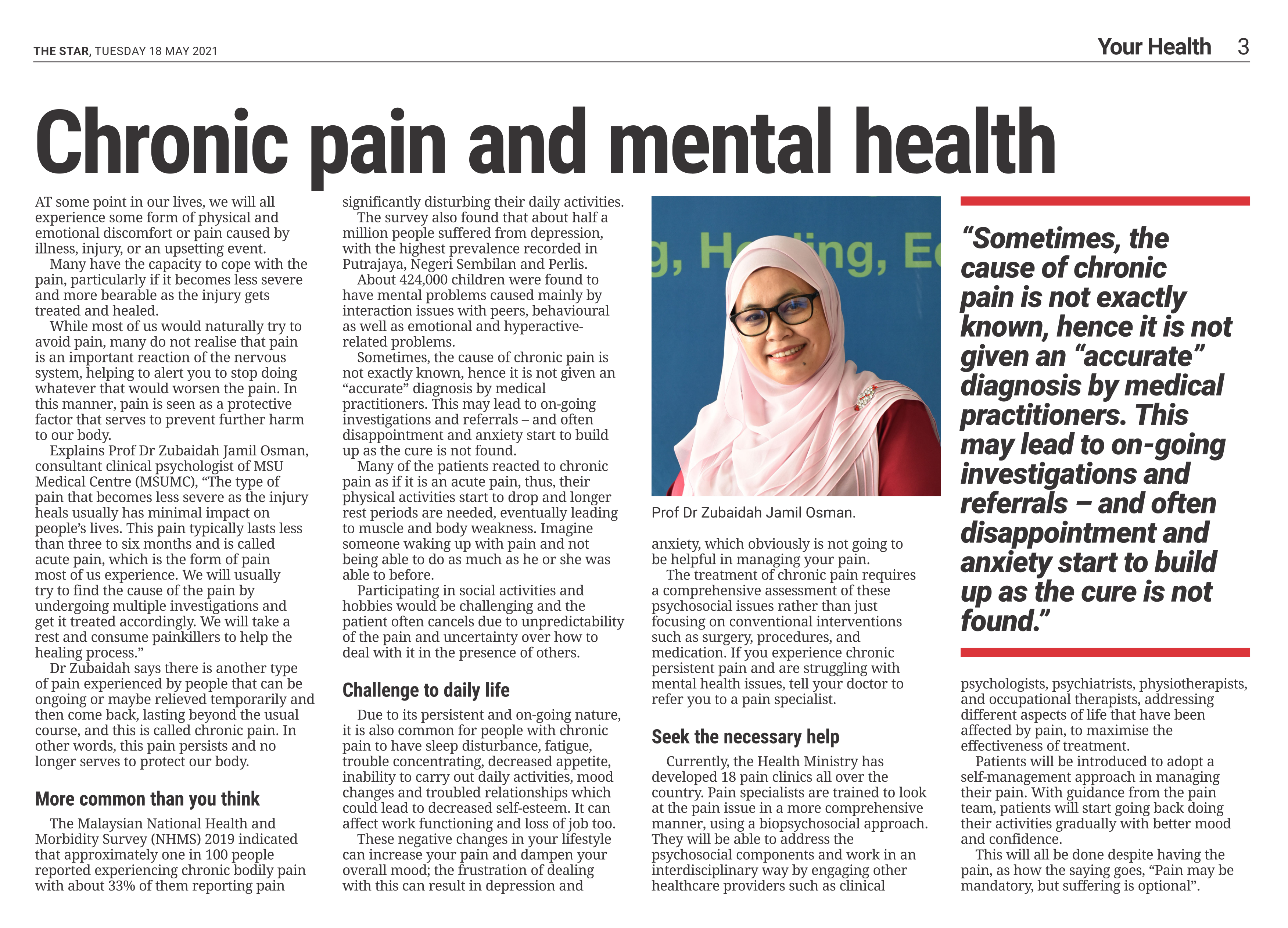THE STAR, TUESDAY 18 MAY 2021 - STAR SPECIAL
AT some point in our lives, we will all experience some form of physical and emotional discomfort or pain caused by illness, injury, or an upsetting event. Many have the capacity to cope with the pain, particularly if it becomes less severe and more bearable as the injury gets treated and healed.
While most of us would naturally try to avoid pain, many do not realise that pain is an important reaction of the nervous system, helping to alert you to stop doing whatever that would worsen the pain. In this manner, pain is seen as a protective factor that serves to prevent further harm to our body.
Explains Prof Dr Zubaidah Jamil Osman, consultant clinical psychologist of MSU Medical Centre (MSUMC), “The type of pain that becomes less severe as the injury heals usually has minimal impact on people’s lives. This pain typically lasts less than three to six months and is called acute pain, which is the form of pain most of us experience. We will usually try to find the cause of the pain by undergoing multiple investigations and get it treated accordingly. We will take a rest and consume painkillers to help the healing process.”
Dr Zubaidah says there is another type of pain experienced by people that can be ongoing or maybe relieved temporarily and then come back, lasting beyond the usual course, and this is called chronic pain. In other words, this pain persists and no longer serves to protect our body.
More common than you think
The Malaysian National Health and Morbidity Survey (NHMS) 2019 indicated that approximately one in 100 people reported experiencing chronic bodily pain with about 33% of them reporting pain significantly disturbing their daily activities.
The survey also found that about half a million people suffered from depression, with the highest prevalence recorded in Putrajaya, Negeri Sembilan and Perlis.
About 424,000 children were found to have mental problems caused mainly by interaction issues with peers, behavioural as well as emotional and hyperactiverelated problems.
Sometimes, the cause of chronic pain is not exactly known, hence it is not given an “accurate” diagnosis by medical practitioners. This may lead to on-going investigations and referrals – and often disappointment and anxiety start to build up as the cure is not found.
Many of the patients reacted to chronic pain as if it is an acute pain, thus, their physical activities start to drop and longer rest periods are needed, eventually leading to muscle and body weakness. Imagine someone waking up with pain and not being able to do as much as he or she was able to before.
Participating in social activities and hobbies would be challenging and the patient often cancels due to unpredictability of the pain and uncertainty over how to deal with it in the presence of others.
Challenge to daily life Due to its persistent and on-going nature, it is also common for people with chronic pain to have sleep disturbance, fatigue, trouble concentrating, decreased appetite, inability to carry out daily activities, mood changes and troubled relationships which could lead to decreased self-esteem. It can affect work functioning and loss of job too.
These negative changes in your lifestyle can increase your pain and dampen your overall mood; the frustration of dealing with this can result in depression and anxiety, which obviously is not going to be helpful in managing your pain.
The treatment of chronic pain requires a comprehensive assessment of these psychosocial issues rather than just focusing on conventional interventions such as surgery, procedures, and medication. If you experience chronic persistent pain and are struggling with mental health issues, tell your doctor to refer you to a pain specialist.
Seek the necessary help Currently, the Health Ministry has developed 18 pain clinics all over the country. Pain specialists are trained to look at the pain issue in a more comprehensive manner, using a biopsychosocial approach.
They will be able to address the psychosocial components and work in an interdisciplinary way by engaging other healthcare providers such as clinical psychologists, psychiatrists, physiotherapists, and occupational therapists, addressing different aspects of life that have been affected by pain, to maximise the effectiveness of treatment.
Patients will be introduced to adopt a self-management approach in managing their pain. With guidance from the pain team, patients will start going back doing their activities gradually with better mood and confidence.
This will all be done despite having the pain, as how the saying goes, “Pain may be mandatory, but suffering is optional”.

